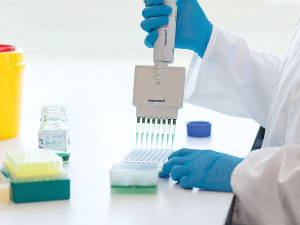Pest confirmed on West Coast
A tropical insect pest with a big appetite for corn has been identified on the West Coast, the first time it has been found in the South Island.
 The National Animal Health Laboratory has acquired a $580,000 robot to perform animal disease testing.
The National Animal Health Laboratory has acquired a $580,000 robot to perform animal disease testing.
Could robotics be the secret to faster and improved animal disease testing?
It’s certainly a possibility, say Biosecurity New Zealand, who recently invested in a new antibody testing robot for the National Animal Health Laboratory.
The $580,000 high throughput diagnostic robot is the first of its kind in New Zealand and it is said will increase testing accuracy and consistency during future biosecurity responses.
“The Mycoplasma bovis outbreak gave us useful insights into how our laboratory could increase its capacity during a response. In particular, it highlighted the need for automation,” says Animal Health Laboratory manager Joseph O’Keefe.
“If an exotic disease such as foot-and-mouth disease (FMD) arrived here, our people could need to test some 3,000 up to 7,000 samples a day,” he says.
O’Keefe says automating the process will speed up the delivery of results, making the process faster for farmers and better for the wellbeing of everyone involved.
The Explorer G3 workstation was manufactured in Germany and is designed to test up to 7,000 samples per day for antibodies to FMD and other exotic diseases.
O’Keefe says the robot doesn’t need frequent attention or intervention, freeing Animal Health Laboratory staff for other testing and providing stability throughout intense response periods.
It can also run tests overnight without staff present.
“Testing delays can affect our economy as antibody testing is essential for maintaining the access and security of product exports to New Zealand’s international markets. If there is an exotic disease outbreak in New Zealand’s animals, automation will allow us to recover faster.”
The 750kg robot took a week to set up, with each part being brought safely into the biosecure containment area.
Once it was assembled, the team ran it through stringent testing and calibration to ensure the tests were as accurate as the current manual process. Now that this has been confirmed, the robot has begun day-to-day diagnostic testing.
The machine achieves its efficiency through moving test plates around. Each plate can contain approximately 90 samples and the robot manages up to 40 plates at once. Simultaneously, it adds samples and different reagents, washes and incubates the test plates.
Outside of responses, the robot is used to perform antibody tests for surveillance programmers, and for testing groups of animals for import or export purposes.
Ministry for Primary Industries (MPI) director general Ray Smith says job cuts announced this morning will not impact the way the Ministry is organised or merge business units.
Scales Corporation is acquiring a number of orchard assets from Bostock Group.
Family and solidarity shone through at the 75 years of Ferdon sale in Otorohanga last month.
The Ministry for Primary Industries (MPI) has informed staff it will cut 391 jobs following a consultation period.
New Zealand farmers are committed to making their businesses more resilient to climate change and are embracing innovation to help them do so.
Atiamuri farmers Paul and Lesley Grey never gave up their dream of owning their own farm – and in 2020, that dream came true.

OPINION: This old mutt well remembers the wailing, whining and gnashing of teeth by former West Coast MP and Labour…
OPINION: Your canine crusader gets a little fed up with the some in media, union hacks, opposition politicians and hard-core…